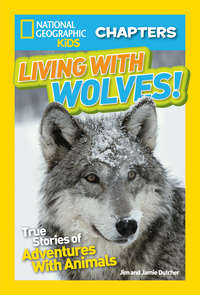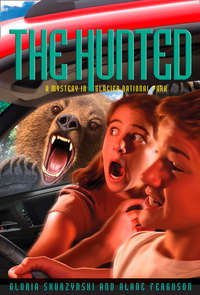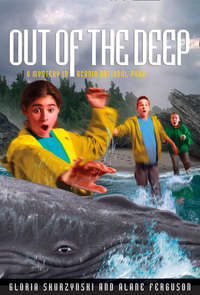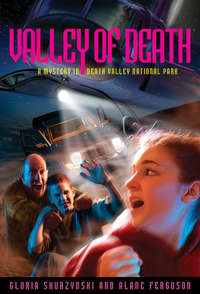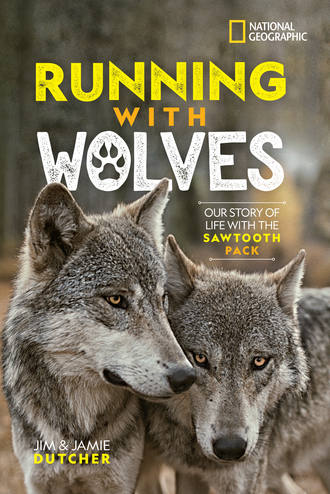
Полная версия
Running with Wolves

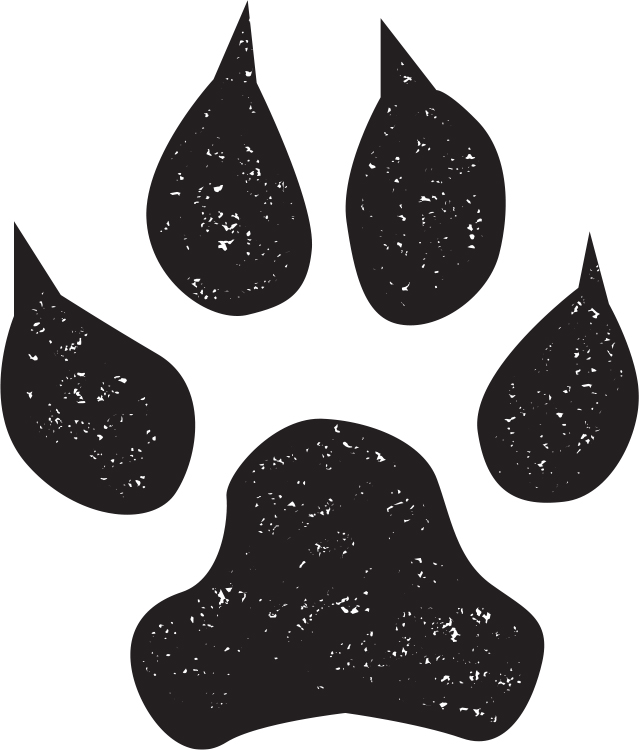
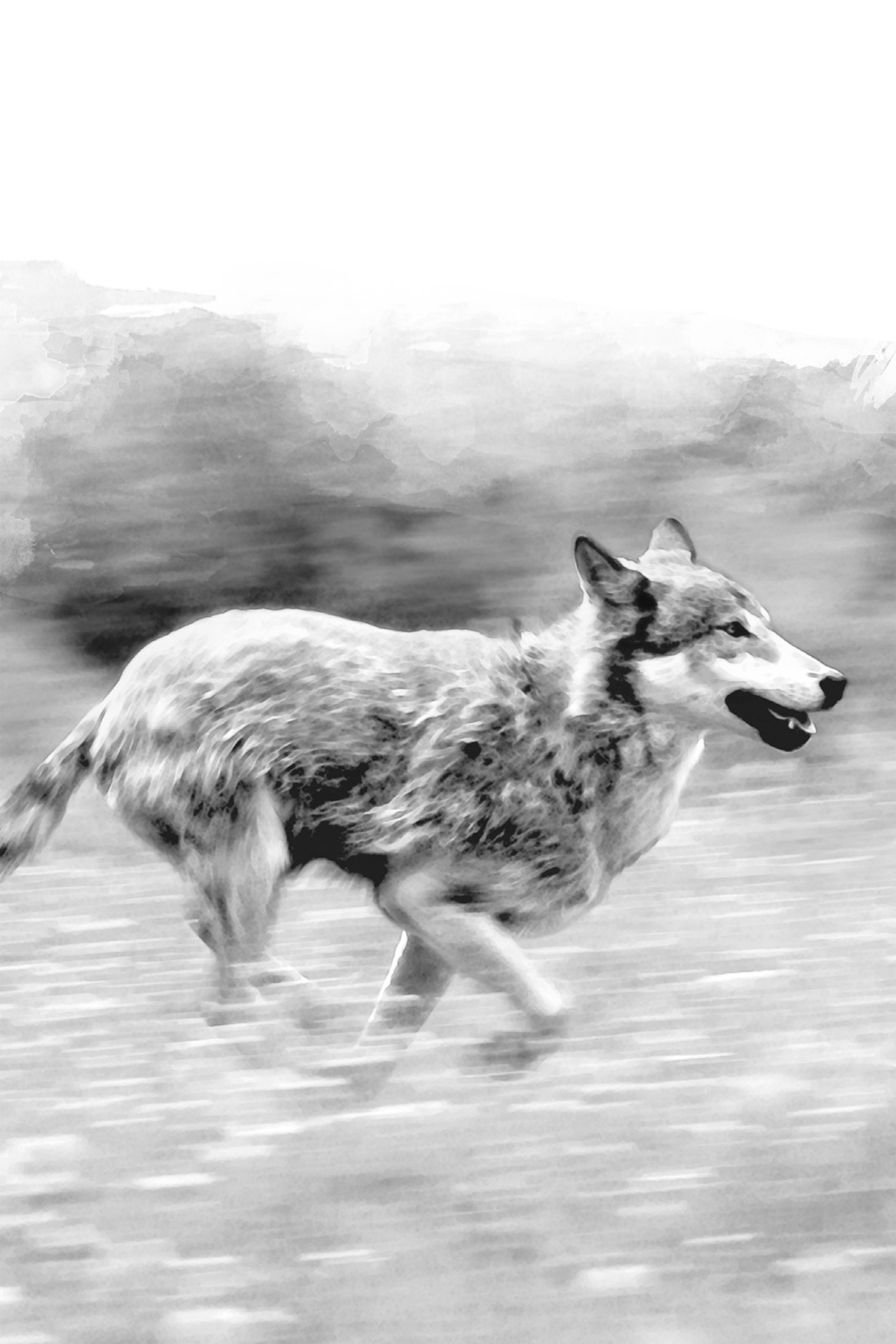
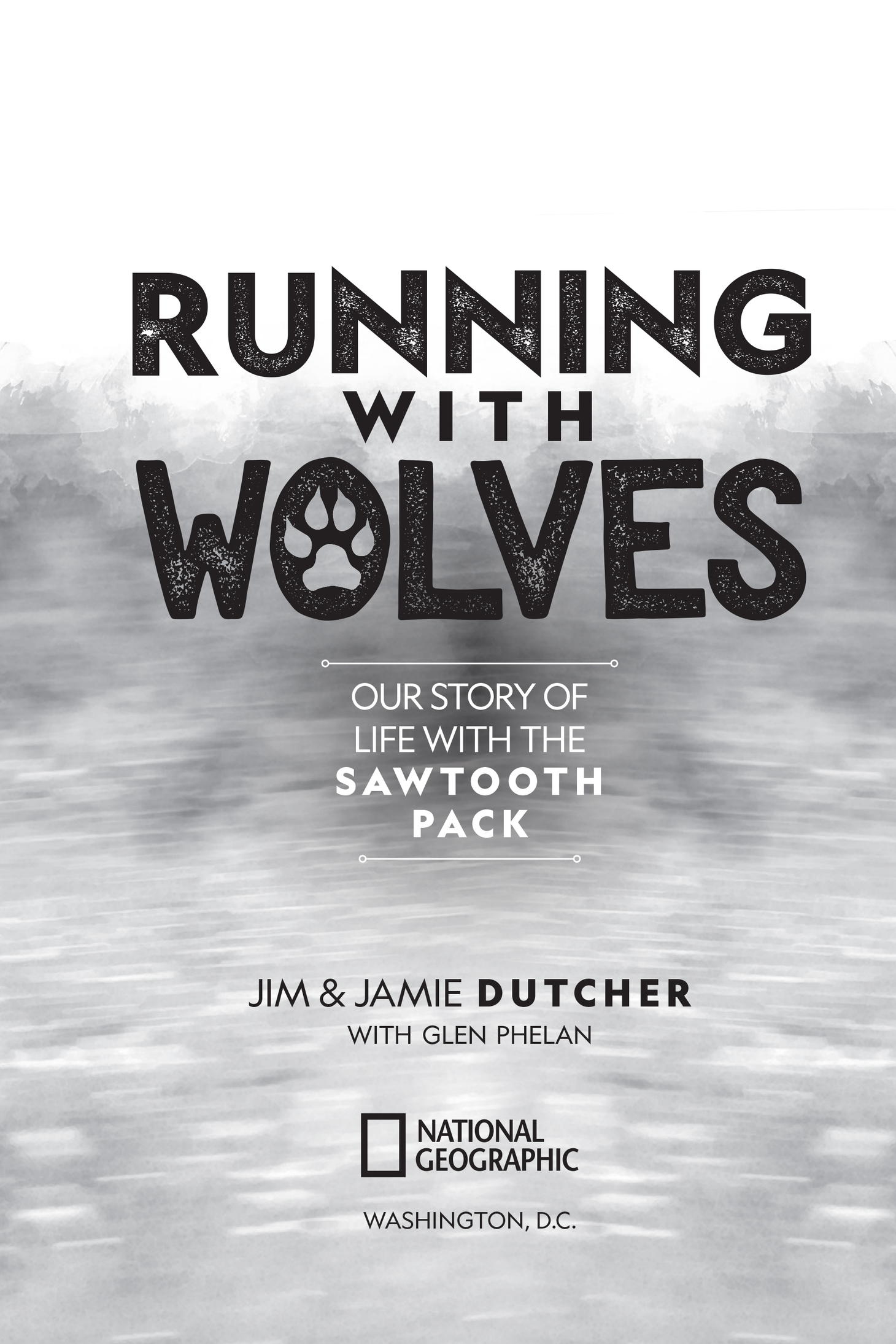

Text and photographs Copyright © 2019 Jim and Jamie Dutcher
Compilation Copyright © 2019 National Geographic Partners, LLC
Published by National Geographic Partners, LLC. All rights reserved. Reproduction of the whole or any part of the contents without written permission from the publisher is prohibited.
Since 1888, the National Geographic Society has funded more than 12,000 research, exploration, and preservation projects around the world. The Society receives funds from National Geographic Partners, LLC, funded in part by your purchase. A portion of the proceeds from this book supports this vital work. To learn more, visit natgeo.com/info.
NATIONAL GEOGRAPHIC and Yellow Border Design are trademarks of the National Geographic Society, used under license.
For more information, visit nationalgeographic.com, call 1-800-647-5463, or write to the following address:
National Geographic Partners
1145 17th Street N.W.
Washington, D.C. 20036-4688 U.S.A.
Visit us online at nationalgeographic.com/books
For librarians and teachers: ngchildrensbooks.org
More for kids from National Geographic: natgeokids.com
National Geographic Kids magazine inspires children to explore their world with fun yet educational articles on animals, science, nature, and more. Using fresh storytelling and amazing photography, Nat Geo Kids shows kids ages 6 to 14 the fascinating truth about the world—and why they should care. kids.nationalgeographic.com/subscribe
For rights or permissions inquiries, please contact National Geographic Books Subsidiary Rights: bookrights@natgeo.com
Designed by Sanjida Rashid
Map: Evelyn B. Phillips; Map: National Geographic Maps; Illustration: Fernando G. Baptista.
The publisher would like to thank everyone who made this book possible: Kate Hale, executive editor; Paige Towler, associate editor; Mike McNey, cartographer; Shannon Hibberd, senior photo editor; Sally Abbey, managing editor; Joan Gossett, editorial production manager; and Anne LeongSon and Gus Tello, production assistants.
Hardcover ISBN: 978-1-4263-3358-3
Reinforced library binding ISBN: 978-1-4263-3359-0
Ebook ISBN 9781426333606
v5.4
a

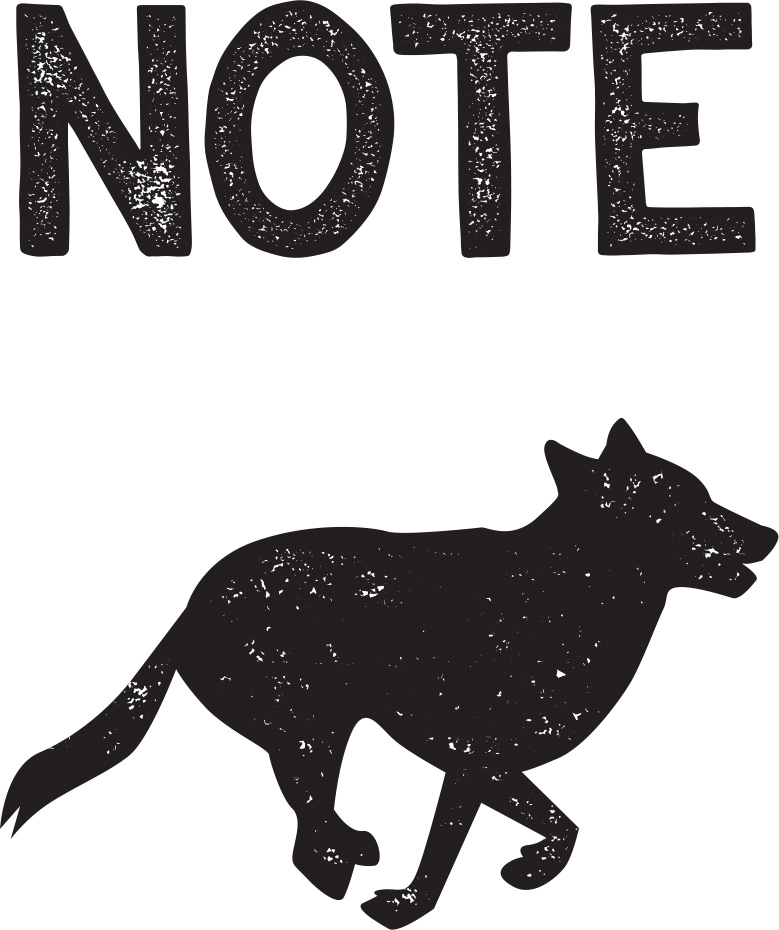
Jim and Jamie Dutcher grew up in different places, but they both loved exploring the great outdoors. They had a passion for observing wildlife that continues to this day. Along with that passion comes immense respect for wild animals, and for their wildness. If you see a wild animal, be respectful just like Jim and Jamie. Observe the animal from a safe distance and don’t disturb it. Let it be wild.
In this memoir, Jim and Jamie each tell different parts of their adventures with wolves. Jim tells much of the first half because Jamie didn’t join the wolf project until its third year. Yet, she was always very much a part of it. Long before she arrived at wolf camp, Jamie helped keep the project on a steady course through advice and encouragement offered in letters and phone conversations. Many of these communications are recalled in this story.

For our grandchildren, Arianna, Sofia, Natalie, Sebastian, and Emiko; our nephew, Sam-Henry; and our niece, Madeline. And for young people everywhere—may you always follow your dreams. Together, we can make a difference for the natural world.
—Jim and Jamie Dutcher

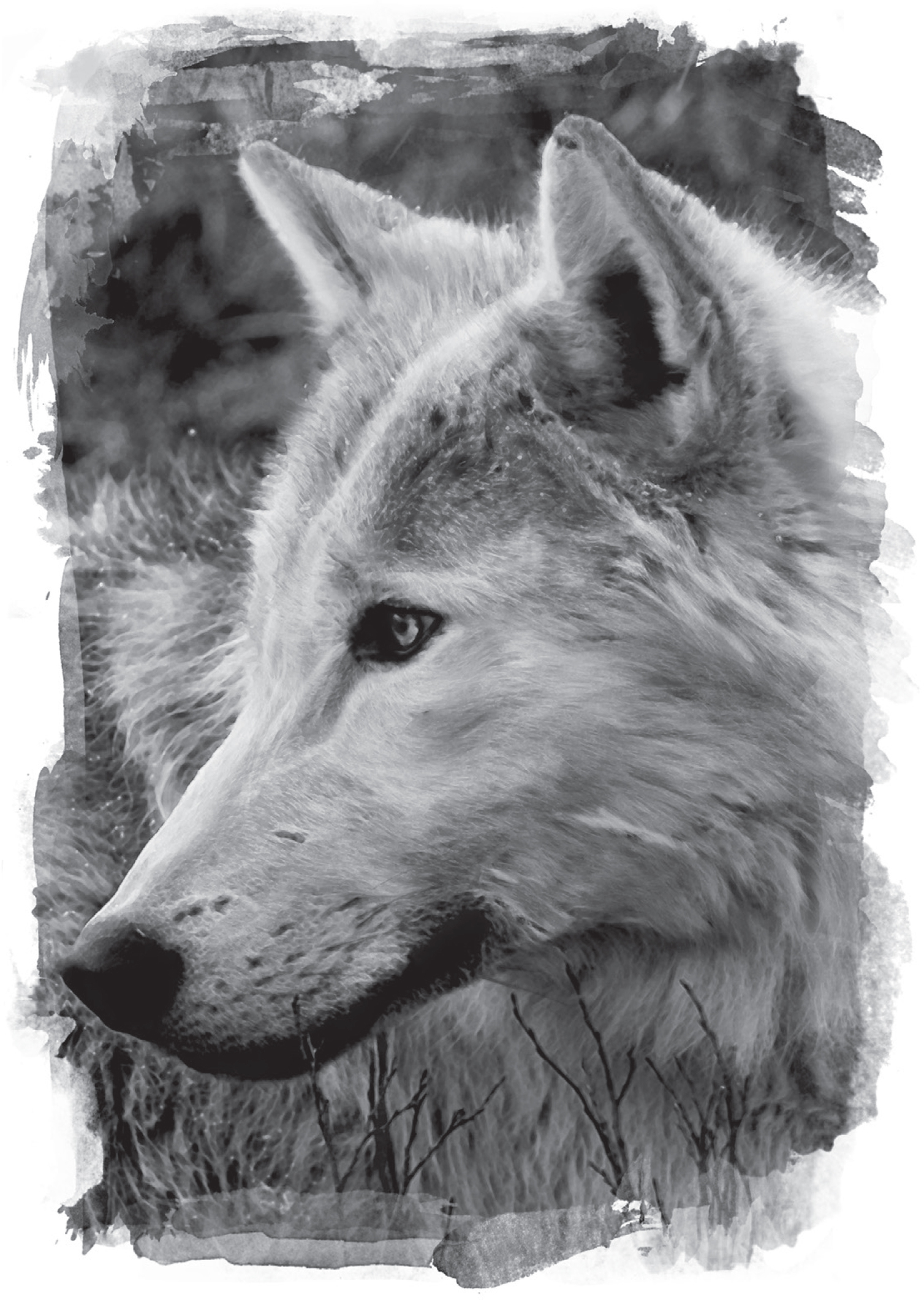

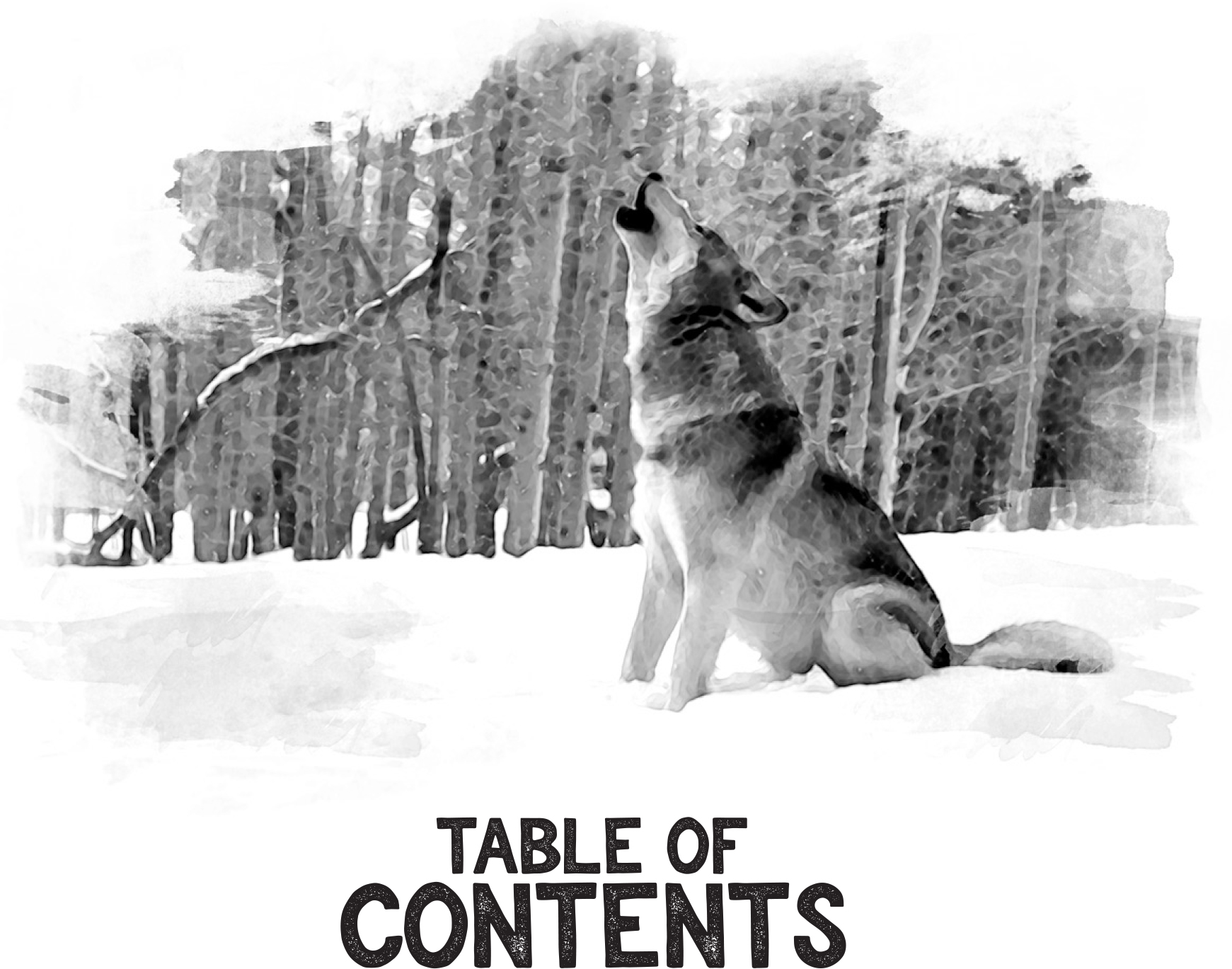

Cover
Title Page
Copyright
Note
Dedication
Map
A WOLF’S TRUST
CHAPTER 1 LONGING FOR WILDERNESS
CHAPTER 2 A BRIGHT IDEA
CHAPTER 3 BEGINNINGS OF THE SAWTOOTH PACK
CHAPTER 4 TROUBLE IN THE PACK
CHAPTER 5 SEASON OF CHANGE
CHAPTER 6 A COMPASSIONATE ALPHA
CHAPTER 7 A GUT-WRENCHING DECISION
CHAPTER 8 NEW ADVENTURES
CHAPTER 9 TWO LEAPS FORWARD
CHAPTER 10 FRIENDS FOR LAKOTA
CHAPTER 11 CALL OF THE WOLF
CHAPTER 12 FAMILY TIES
CHAPTER 13 CELEBRATION!
CHAPTER 14 TIME TO SAY GOODBYE
PHOTO INSERT
EPILOGUE
THE WORLD OF THE WOLF
KEYSTONE SPECIES
ABOUT LIVING WITH WOLVES
ACKNOWLEDGMENTS
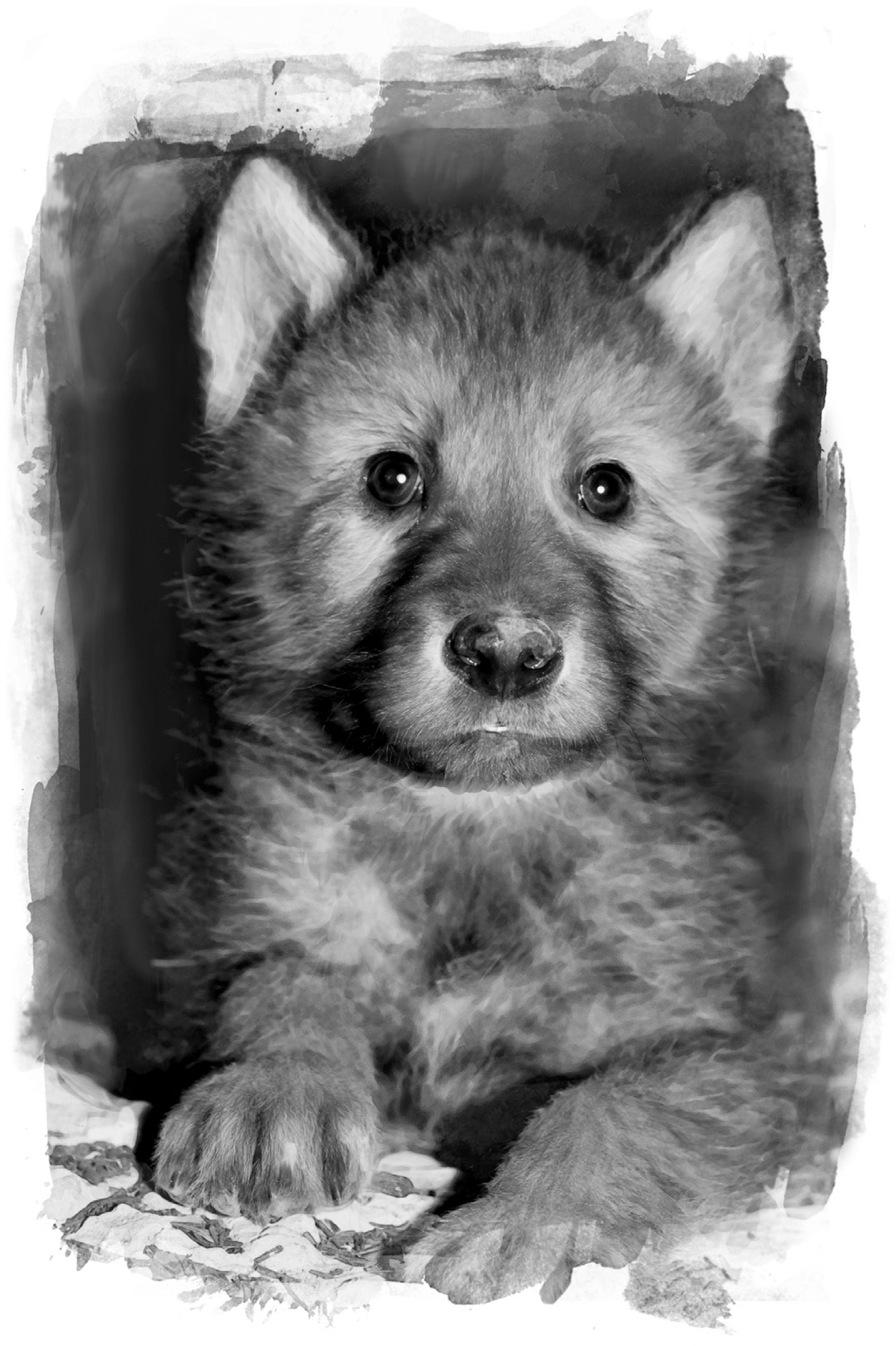
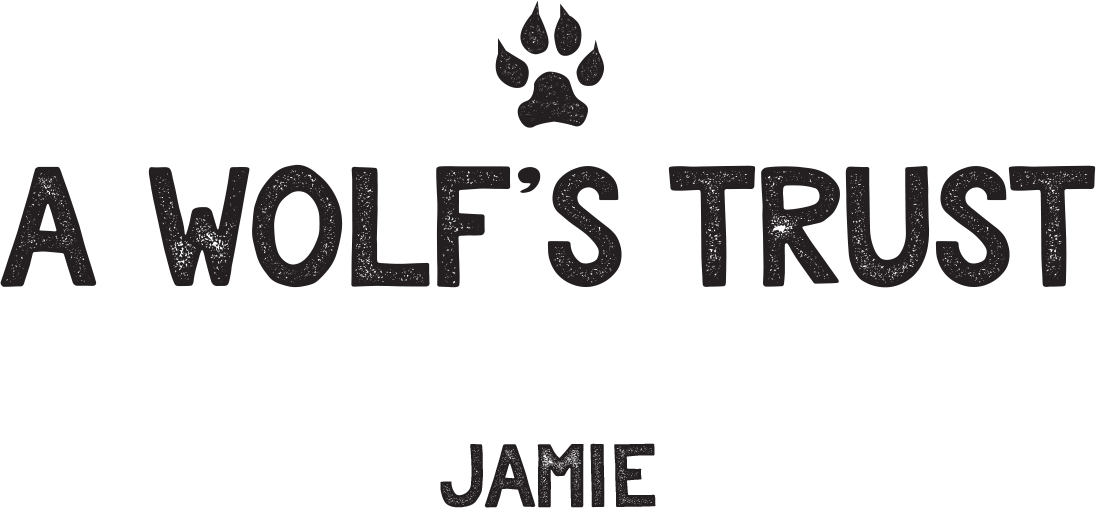
I stood silent and motionless, my eyes trained on the mysterious black hole in front of me. The opening was just two feet (0.6 m) wide, half hidden beneath a fallen spruce tree. Its oval shape reminded me of a dark, mystical eye, like that of a dragon. Such a thought of fantasy contrasted sharply with the reality of what I was about to do. It was something that no one had likely ever done.
I sniffled against the chilly April air. Spring had sprung a month earlier, according to the calendar anyway. Somewhere nourishing rains and lengthening days were coaxing flowers to show their colorful faces. Somewhere tree buds were awakening from their long winter rest, and grass was once again growing green.
Somewhere, but not here. Snow still covered most of the ground in the forest that surrounded me. The warmth of the season comes late, and slowly, to the mountains of Idaho.
I glanced at my husband, Jim, through a cloud of my condensed breath. He crouched nearby behind his movie camera. All of his years as a filmmaker led up to this moment, and he wasn’t about to let it slip by without capturing it on film.
Looking up from his eyepiece, he nodded. I walked cautiously toward the gaping black hole. With each step, I became more aware of the sounds around me. The gentle rush of a breeze and the chirping of black-capped chickadees mingled with the crunching and squishing of snow and mud under my boots. My own heartbeat reverberated through several layers of clothing.
There were other sounds, too. Distinct chirps, almost birdlike, pierced the frigid air. The source was unseen, distant yet nearby, but I knew what it was. So did the wolves.
Seven big and powerful gray wolves were gathered around the opening, pacing back and forth and trampling the ground into a muddy mess. They couldn’t go in—they instinctively knew that—so they took turns peering into the hole as they whined with excitement.
As I slowly reached the wolves, they made way for me, as if I were one of them. I knelt down on the damp ground and stared at the opening. Barely a minute went by. Then suddenly a wolf poked her head out. Her yellow eyes set against her black face were like two piercing lights. The sight would have startled—and maybe frightened—most people. But I knew those eyes well. They looked curious…intelligent…calm.
The black wolf emerged completely, revealing her full size. She greeted me with a tender whine, gave me a little lick on the nose, and sat beside me. We looked at each other. I gently spoke and asked if I could go where she had been. I tried to read her body language for any signs of fear or uncertainty. Was she annoyed that I was here? Would she attack me? She never had, but today was unlike any other, and quite frankly I wanted to make sure she wouldn’t bite me on the behind.
Her expression seemed only to say, “It’s okay, go on in. I trust you.”
That was the invitation I was hoping for. I took out a small flashlight from my jacket pocket and showed it to her. She inspected it and seemed satisfied that it posed no threat. I smiled and took a deep breath. Then I flicked on the light, lowered my head, and leaned in…
Why was I about to squeeze myself into this dark, damp hole in the ground? What did I expect to find? Stranger still, why was a large, powerful wolf sitting calmly beside me as I prepared to enter a place so precious to her that even other wolves were not allowed?
The answers to these questions are at the heart of this story. It’s a story of our adventures. It’s a story of our struggle and survival and the wolves’ struggle and survival, but also of trust, friendship, and even love. It’s a story of what happens when two people decide it would be a good idea to spend six years living in the wilderness with a pack of wolves.
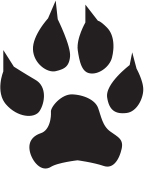
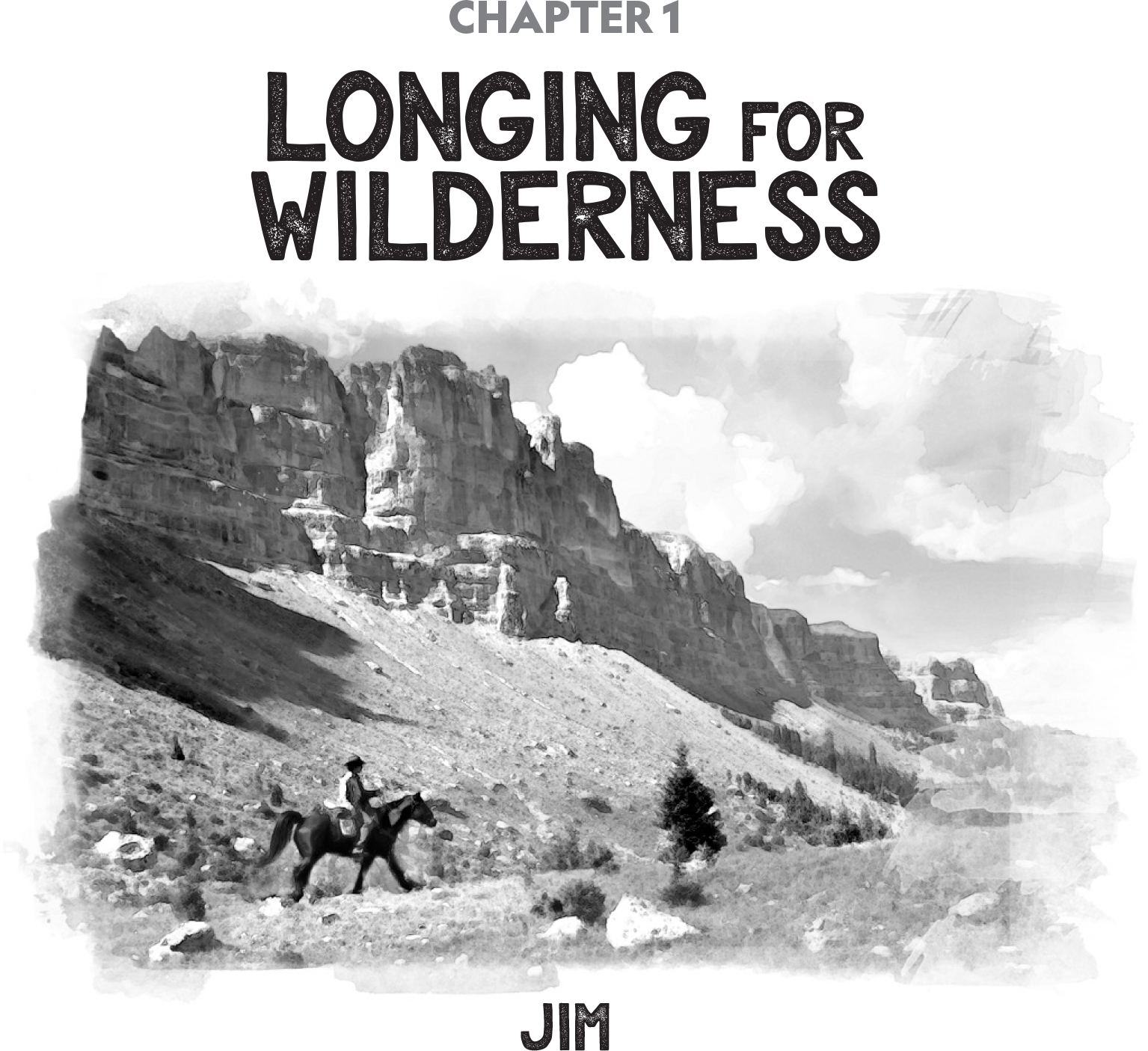
I tugged gently on the worn leather reins, and Glendora, my buckskin mare, came to a slow halt. She turned her head to look back at me and I leaned down in the saddle to give her a reassuring pat on the neck. We both knew we had a job to do, but the view was just too spectacular to miss. I needed a minute to take it all in.
It was first light—my favorite time of day. The sun had just peeked above the horizon and its glorious rays began to illuminate the landscape. A beautiful lake shimmered in the growing light. Its smooth surface mirrored perfectly the fast-changing colors of the early morning sky—from golden yellow to deep pink to rich azure blue. Bright wildflowers dotted the green grassy meadows that surrounded the lake.
What dominated the landscape, though, were the mountains. In almost every direction, forests swept up to the base of sheer rocky cliffs that reached at least 2,000 feet (610 m) toward the sky. Most of the mountains formed walls of layered rock, like those of the Grand Canyon, rather than peaks. The ashen gray cliffs looked dull compared to the rich palette of the valley below.
But sunlight is nature’s artist, and it can turn a colorless canvas into a dazzling masterpiece. That’s what I was waiting to see on this clear, chilly summer morning. As the sun inched its way into the sky, the light crept down the east-facing cliffs to my right, transforming the somber gray first into a rosy pink and then a brilliant orange. The rock seemed to glow. The effect soon passed, but as always, it was breathtaking.
I looked south across the lake to the ranch on the far shore. Then, taking a deep gulp of fresh mountain air, I sat up straight in the saddle, thought for the umpteenth time how lucky I was, and announced to my trusty companion, “Okay, Glennie, let’s round up these ponies.”
The year was 1959. I was 16 years old and had the summer job of a lifetime—I got to be a cowboy! Well, a wrangler actually. A cowboy herds cattle; a wrangler herds horses.
I worked on a ranch in the high country of Wyoming. By “high country,” I mean the ranch sat at 9,200 feet (2,804 m) above sea level. There, among the peaks of the Absaroka Range, I felt like I was on top of the world. The location couldn’t have been more perfect. The ranch sat on a hill above the mountain lake. Beyond the ranch stood a deep green forest of pine. The views were awe-inspiring no matter where I was, and not only at first light.
Then, as now, this part of the Rocky Mountains was far less known than the nearby tourist attractions of Yellowstone National Park. That was just fine with me. I could roam and explore the pristine wilderness without seeing a single person. That is, once my daily chores were done.
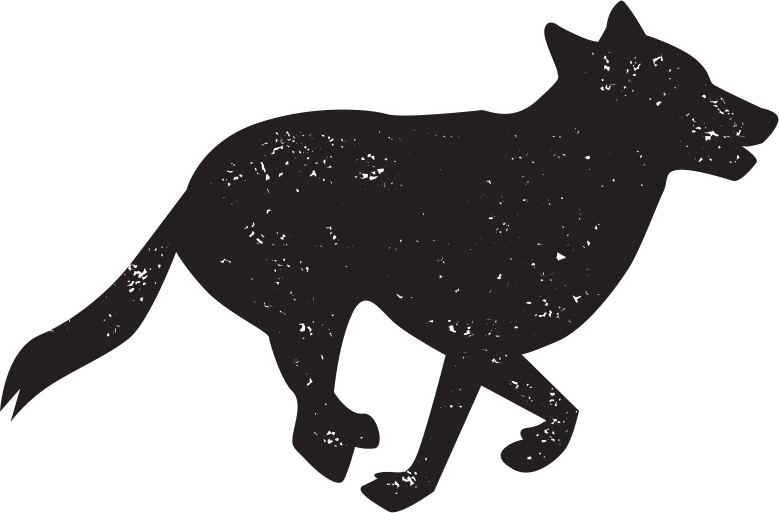
Each evening before sundown, I would drive a herd of about two dozen horses from the ranch to a meadow on the other side of the lake. There I would leave them to graze, drink from a cool mountain stream, and sleep peacefully among the willows and meadow grasses.
Then every morning I had to go get the horses and take them back to the corral. This wasn’t a job for anyone who liked to sleep in. I would rise from my bunk bed well before dawn and dress quickly—not only because I wanted to hit the trail but also to stay warm. At this high elevation, the early morning air was cold, and usually I wore two pairs of jeans, a long-sleeve shirt, and a jacket. My leather gloves and cowboy hat also provided some warmth.
I really didn’t mind the cold weather, though. In fact, for a kid who grew up in subtropical Florida, these cool summers were welcome, even exhilarating.
So, looking every bit the part of a movie cowboy, I’d ride Glendora back to the meadow just as the faintest glimmer of light began to tinge the dark eastern sky and the jagged peaks of the Pinnacle Buttes. The well-rested horses would usually be on their feet by the time we arrived, finishing a breakfast of soft, dew-covered grass.
I’d circle around to the far side of the herd and push them together in the direction of the ranch. I didn’t literally push the horses. Instead, I’d come up from behind and call out “Hee-yah!” Off they’d gallop. I would feel the rumble through my body as their hooves pounded the ground.
Sometimes the horses would spook and bolt in another direction. Glendora would take off after them with little coaxing from me. It’s a good thing she knew her job so well, because during these hard gallops I could do little more than hang on for dear life.
Eventually we’d round up the herd. Then I’d ride behind or alongside the horses to guide them the two miles (3 km) back to the corral for the day.
That was the general idea, anyway. When you’re dealing with animals, things don’t always go according to plan.
Often, I’d discover that other large animals, hidden from view, had visited the herd during the night—and they were sticking around for breakfast.
You might not think a meadow could provide much cover for anything larger than a ground squirrel or a mouse. But the willows were a bit taller than me and grew in tangled bunches, like dense bushes. Even sitting high in the saddle, it was difficult to see more than just the backs of the horses grazing in between the willows. It wasn’t until I started flushing the horses out that I noticed some of them didn’t look like the others. Some had antlers! To my surprise, I realized that I was rounding up not only horses but also a few very confused moose.
I felt sorry for them. The moose must’ve been completely bewildered, wondering why their breakfast had been disturbed by a stampede—and why they were in the middle of it! Sorry or not, I had to separate these wild animals from the herd.
Easier said than done.
Moose aren’t usually aggressive, but if they feel harassed or threatened, watch out! They can kick their sharp, pointed hooves forward, backward, and sideways. I didn’t want to be on the receiving end of one of those powerful thrusts. And I sure didn’t want to mess with those antlers. They were wider than my arm span. One quick move of the moose’s neck and his massive bony headgear could crush my leg or Glendora’s skull. I didn’t dare get too close.
So instead of separating the moose from the herd, I separated the herd from the moose, pushing the horses away as I normally did. Now and then, the moose followed or ran with the herd for a while. Maybe they didn’t want to leave their new companions. Or maybe they just wanted to see where everyone was going. Whatever the reason, their stomachs usually won out, and they’d trot back to the meadow for breakfast.
Dealing with moose tested my horse-riding skills and helped keep the job from ever becoming boring. Not that there was much chance of that happening. Something was always keeping me on my toes.

If moose weren’t visiting the meadow, strays were leaving it.
Strays were horses that wandered off early in the morning, before I got to the herd. I knew each of the 28 steeds in my charge and could tell quickly when one or more were missing. It always seemed to be the same restless few that wandered, so I had tied bells around their necks earlier in the summer for easy tracking.
One day, several horses had wandered off into the forested hills on the other side of the meadow. After driving the rest of the herd back to the ranch, I returned to collect the strays.
It was so quiet. Away from the herd, the ranch, and anything with a motor, I could hear the slightest sounds—the shriek of a hawk high above or the trickling of a winding brook. So it was no surprise that I picked up the faint tinkling of bells coming from the forest across the meadow. Glendora and I followed the distant ding, ding, ding up into the foothills.
These were my favorite times. Tracking strays gave me a chance to explore the countryside. The cool air, the wilderness, and the freedom were all so new to me, and thrilling. I was living my dream of roaming the Great American West.
That morning we searched more than usual as we followed the bells farther and farther into the Wyoming backcountry. It was slow going. We blazed our own trails as we picked our way through forests, creeks, and clearings. Wooded ravines were the toughest to navigate. I leaned back in the saddle to make the downslope easier on Glendora. Then she quickly scooted up the other side. On hard ground, I stopped every few minutes so that the clip-clop of horseshoes didn’t drown out the distant sound of bells.
We were an hour or so into our journey. The sun had climbed higher in the sky and I welcomed the growing warmth. I pushed aside a low-hanging branch as we stepped out of the forest into a large clearing. Suddenly we stopped in our tracks.
Beyond the clearing, groves of dark green lodgepole pines gave way to a steep grassy slope strewn with boulders from the rock formation that towered high above: Brooks Mountain. Its majestic cliffs rise 1,300 feet (396 m) straight up. This mass of rock stretches for more than a mile and is part of the Continental Divide—the long line of high elevations that zigzags its way north and south across the continent and separates river systems that flow to the Pacific from those that flow to the Atlantic.
I had seen Brooks Mountain many times, and it always struck me as magnificent, but at that moment, something else caught my attention.
Across the clearing stood a coyote.
It’s not that the sight of a coyote was a heart-stopping shock. It wasn’t. All sorts of animals big and small roamed the countryside. I had seen eagles soaring above the cliffs, black bears nibbling berries, herds of elk grazing in open meadows, and more.
Coyotes were common, too, but they were skittish. Ranchers hunted them, afraid that the carnivores would harm their livestock. Consequently, coyotes had learned to quickly run away when they saw or smelled a human approaching.
Not this coyote. He and I were having a staring contest.
He didn’t seem the least bit afraid, just curious about this two-legged creature sitting atop a four-legged creature across the meadow. Something else was different about him. Even from a distance I could tell that he was larger than any coyote I had ever seen. His legs were longer and his face broader.
Then it hit me. This wasn’t a coyote at all. It was a wolf!
Glendora became restless. She snorted and neighed, shook her head several times, and stepped in place nervously. “Easy, girl,” I said as I gently patted her neck. Glendora calmed down, but I wanted a closer look, so I coaxed her to slowly follow the edge of the clearing and head toward the wolf.
I learned two things about wolves that day—they’re smart and they’re curious. While we circled the edge of the clearing, the wolf did, too, in the same direction so as to keep the same distance between us. His yellow eyes stayed locked on mine as we both circled the meadow. Eventually we each ended up where the other had stood.
The wolf inspected where Glendora had trampled the grass. He showed no signs of fear, no signs of aggression, only cool curiosity. What were we? Were we a threat? He seemed to be pondering these questions. I watched, fascinated, and wondered what conclusions he had drawn.
I couldn’t take my eyes off this large, furry, doglike creature—a predator that I had long heard was an aggressive, vicious, unforgiving killer. I saw none of that. All I saw was intelligence and fearlessness…but only for a minute longer. Then, the wolf simply turned and trotted away and disappeared among the pines.
Eventually, I found the stray horses. They were safe and sound, but I never saw the wolf again. No wonder. I later discovered that seeing a wolf at that time in that place—my very first wolf sighting—had been an incredibly rare event. In 1959 as few as 15 wolves lived in the U.S. Rocky Mountains, and I had seen one of them. I wouldn’t see another for 30 years.
And when I did, it would change my life forever.


The zookeeper burst through the doorway. The front of her T-shirt was untucked, with the bottom folded up like a soft taco shell, and her hands clearly cradled an object within.
“It’s a joey!” the keeper exclaimed. An involuntary gasp escaped my lips as the keeper revealed the precious cargo she was carrying—a tiny, hairless baby kangaroo.
“What happened?” my colleagues and I asked in unison.
“The mother rejected him,” she replied hurriedly. “I don’t know why.”
The keeper, sweating on this hot day in May at Smithsonian’s National Zoo in Washington, D.C., quickly explained that the mother kangaroo had kicked the joey out of her pouch. A visitor had seen the horrifying incident and contacted the zookeeper, who rushed into the enclosure, picked up the squirming youngster, and brought him to me and two other keepers at the zoo hospital.


